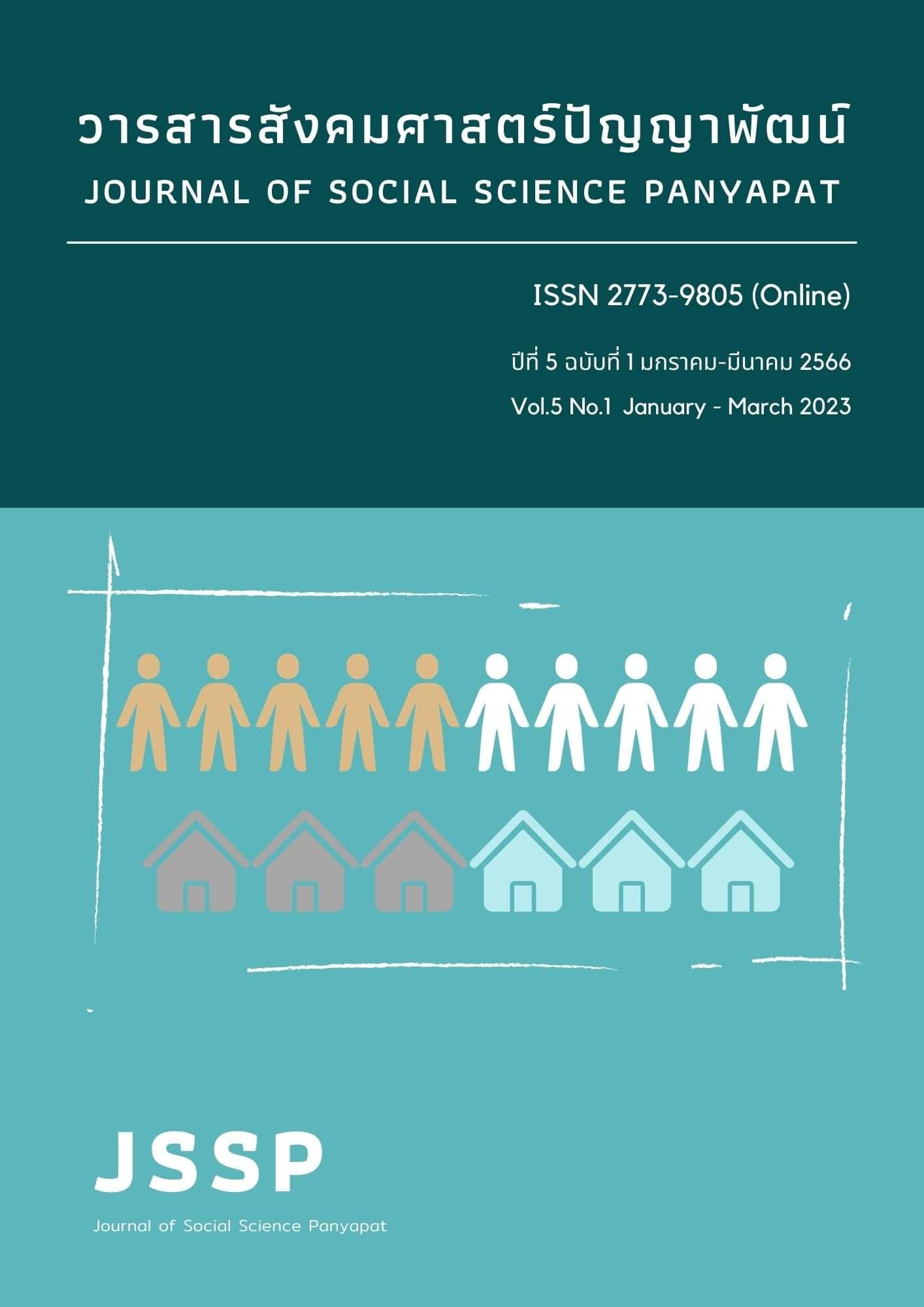ผลกระทบของวัฒนธรรมองค์การต่อการใช้ตัวชี้วัดผลการดำเนินงานขององค์การ และประสิทธิภาพการปฏิบัติงานของพนักงานในอุตสาหกรรม
คำสำคัญ:
วัฒนธรรมองค์การ, การใช้ตัวชี้วัดผลการดำเนินงาน, มุมมองด้านการเงิน, มุมมองที่ไม่เป็นตัวเงิน, ประสิทธิภาพการปฏิบัติงานบทคัดย่อ
บทความนี้มีวัตถุประสงค์เพื่อนำเสนอเรื่องความสำคัญของวัฒนธรรมองค์การ และการใช้ตัวชี้วัดผลการดำเนินงานขององค์การ ที่ส่งผลกระทบต่อประสิทธิภาพการปฏิบัติงานของพนักงานในอุตสาหกรรม จากการศึกษาพบว่า วัฒนธรรมองค์การแบ่งออกเป็น 4 ประเภท ได้แก่ 1) วัฒนธรรมแบบเครือญาติ หรือเน้นการมีส่วนร่วม 2) วัฒนธรรมแบบปรับตัว หรือเน้นการเปลี่ยนแปลงพัฒนา 3) วัฒนธรรมแบบมุ่งผลสำเร็จ หรือเน้นการตลาด 4) วัฒนธรรมแบบราชการ หรือเน้นสายการบังคับบัญชา ผลการดำเนินงานแบ่งออกเป็น 4 ประการ คือ 1) คุณภาพของงาน 2) ปริมาณงาน 3) เวลา และ 4) ค่าใช้จ่ายในการดำเนินงาน การใช้ตัวชี้วัดผลการปฏิบัติงานแบ่งเป็นสองลักษณะคือ มุมมองด้านการเงิน และ ผลการดำเนินงานที่ไม่เป็นตัวเงิน ได้แก่ 1) มุมมองด้านลูกค้า 2) มุมมองด้านกระบวนการทำงานภายในองค์การ และ 3) มุมมองด้านการเรียนรู้และการเติบโต ซึ่งการนำตัวชี้วัดทางการเงินและตัวชี้วัดที่ไม่ใช่การเงินมาใช้ในองค์การนั้น เป็นเรื่องที่จำเป็นและสำคัญต่อองค์การเป็นอย่างมาก ซึ่งนอกจากจะเป็นแบบแผนในการควบคุมและวัดผลแล้ว ยังมีประโยชน์ต่อการบริหารจัดการประสิทธิภาพการปฏิบัติงานของพนักงาน และนำไปสู่ความสำเร็จขององค์การได้
เอกสารอ้างอิง
ณรงค์วิทย์ แสนทอง. (2544). การบริหารทรัพยากรมนุษย์สมัยใหม่. กรุงเทพฯ: เอชอาร์เซ็นเตอร์.
ณัฐธิดา ชูเจริญพิพัฒน์. (2555). วัฒนธรรมในองค์การที่มีผลต่อการปฏิบัติงานของพนักงานธนาคารไทยพาณิชย์เขตนครสวรรค์. (บริหารธุรกิจมหาบัณฑิต, มหาวิทยาลัยเทคโนโลยีราชมงคลธัญบุรี).
นริศย์ จําปา. (2556). วัฒนธรรมองค์การที่มีผลต่อการปฏิบัติงานของพนักงานธนาคารเพื่อการเกษตรและสหกรณ์การเกษตร (ธ.ก.ส.) จังหวัดระนอง. (รัฐประศาสนศาสตรมหาบัณฑิต, มหาวิทยาลัยบูรพา).
ปรีดาภรณ์ บุญเลิศ. (2560). วัฒนธรรมองค์การทีมีผลต่อประสิทธิภาพการทํางานของบุคลากรบริษัทอุตสาหกรรมสีเคลือบผิวแห่งหนึ่ง นิคมอุตสาหกรรมอมตะนคร จังหวัดชลบุรี. (บริหารธุรกิจมหาบัณฑิต, มหาวิทยาลัยบูรพา).
ปวีณา ต่างประเสิรฐ. (2558). ความแตกต่างของวัฒนธรรมองค์การ และความพึงพอใจของพนักงานไทยในองค์การญี่ปุ่นและองค์การอเมริกัน: กรณีศึกษา อุตสาหกรรมรถยนต์ บริษัท โตโยต้า มอเตอร์ประเทศไทย จํากัด และ บริษัท ฟอร์ด เซลส์แอนด์เซอร์วิส (ประเทศไทย) จํากัด. (การจัดการมหาบัณฑิต, มหาวิทยาลัยมหิดล).
ภคนิจ ศรัทธา. (2549). วัฒนธรรมองค์การที่มีผลต่อประสิทธิภาพการปฏิบัติงานของพนักงาน ในฝ่ายธุรกิจขายตรง บริษัท ยูนิลีเวอร์ ไทย เทรดดิ้ง จํากัด. (บริหารธุรกิจมหาบัณฑิต, มหาวิทยาลัยศรีนครินทรวิโรฒ).
เรืองวิทย์ เกษสุวรรณ. (2554). การจัดการคุณภาพ: จาก TQC ถึง TQM, ISO 9000 และการประกันคุณภาพ. กรุงเทพฯ: บริษัท บพิธการพิมพ์ จำกัด.
ศิลปพร ศรีจั่นเพชร และ พิมพ์ใจ วีรศุทธากร. (2555). การวัดค่าในงานวิจัยด้านบัญชีบริหาร. วารสารวิชาชีพบัญชี, 8(23), 76-90.
สมชัย ศรีสุทธิยากร. (2546) การวัดผลองค์การแบบสมดุล (Balanced Scorecard). กรุงเทพฯ: เอ็กซ์ทรีม มีเดีย.
สำนักงานคณะกรรมการนโยบายเขตพัฒนาพิเศษภาคตะวันออก. (2564). ประกาศคณะกรรมการนโยบายการพัฒนาระเบียงเศรษฐกิจพิเศษ. สืบค้น 20 กันยายน 2565. จาก https://www.eeco.or.th/th/announced-promotion-area.
สุธรรม รัตนโชติ. (2560). การบริหารธุรกิจและการจัดการ. กรุงเทพฯ: ท้อป.
สุพานี สฤษฏ์วานิช. (2544). การบริหารเชิงกลยุทธฺแนวทฤษฎี. กรุงเทพฯ : มหาวิทยาลัยธรรมศาสตร์
สุรีรัตน์ ทองเต๊ะ. (2555). การศึกษาความสัมฤทธิ์ผลของการใช้ตัวชี้วัดผลการดำเนินงาน (KPI) ในมุมมองของระบบวัดผลการปฏิบัติงานดุลยภาพ (BSC) : กรณีศึกษา บริษัท สยามเทค แอนด์ ดีเวลล็อป จำกัด. (บัญชีมหาบัณฑิต, มหาวิทยาลัยธุรกิจบัณฑิตย์).
สุวิมล บัวทอง และ ศิริลักษณ์ บางโชคดี. (2558). การใช้ตัวชี้วัดผลการดำเนินงานทางการเงินและไม่ใช่ทางการเงินภายใต้ทฤษฎีการบริหารเชิงสถานการณ์. วารสารวิชาชีพบัญชี, 11(31), 63-79.
อุทัสน์ วีระศักดิ์การุณย์. (2556). ปัจจัยที่มีผลกระทบต่อความต้องการในการปฏิบัติงานของข้าราชการตำรวจ กองบังคับการอารักขาและควบคุมฝูงชน. (รัฐศาสนศาสตรมหาบัณฑิต, มหาวิทยาลัยราชภัฏวไลยอลงกรณ์ ในพระบรมราชูปถัมภ์).
Allen, R. F. (1985). Four phases for bringing about cultural change. Oxford: Jossey-Bass.
Cameron, K. & Freeman, S. (1999) Cultural Congruence, Strength, and Type: Relationships to Effectiveness. Research in Organizational Change and Development, 5, 23-58.
Chiriac, S. C. V. (2014). The performance of a company-financial-accounting approach. Management Intercultural, (31), 77-81.
Daft & Richard L. (2001). Organization Theory and Design. (7th ed). Ohio: South-Western College Publishing.
Daft & Richard L. (2008). New Era of Management. (2nd ed). China: China Translation and Printing Services.
Daft & Richard L. (2008). The Leadership Experience. (4th ed). Mason, O.H.: Thomson/South-Western.
Denison, D.R. (1990). Corporate Culture and Organizational Effectiveness. New York: Wiley.
Hellriegel, D., & Slocum, J. W. (2011). Organizational behavior (13. b.). Mason, OH: South-Western, Cengage Learning.
Hofstede. (1997). Cultures and organizations: software of the mind. New York: McGraw-Hill.
Kaplan, R.S. & Norton, D.P. (2000). The strategy‐focused organization, how balanced scorecard companies thrive in the new business environment. Boston: Harvard Business School Press.
Kotter, J. P., & Heskett, J. L. (1992). Corporate Culture and Performance. New York: The Free Press.
Lau, C. M. (2011). Nonfinancial and financial performance measures: How do they affect employee role clarity and performance?. Advances in Accounting, 27(2), 286-293.
Lawler, E. E. (1996). La Ventaja Creando Organizaciones Participativas e Innovadoras. Spain, Barcelona: Ediciones Granica SA.
Peterson, E., & Plowman, E.G. (1989). Business organization and management. llinois: Richard D. Irwin.
Rahman, M. S. (2012). Service quality, corporate image and customer’s satisfaction towards customers perception: an exploratory study on telecom customers in Bangladesh. Business Intelligence Journal, 5(1), 56-63.
Richard L. Daft. (2004). Organization Theory and Design. (8th ed.). Australia, Thomson: South-Westem.
Sarmawa, I., Superta, I., Riana, I. & Munuati. I. (2017). Influence of Self-Leadership on Employee Performance With Work Culture As Mediator: Study At Tenun Ikat Industries in Klungkung-Bali, Indonesia. International Journal Economic, Commerce and Management, 5(12), 264-276.
Stangor, C. E. (2000). Stereotypes and prejudice: Essential readings. Philadelphia, PA: Psychology Press.
ดาวน์โหลด
เผยแพร่แล้ว
รูปแบบการอ้างอิง
ฉบับ
ประเภทบทความ
สัญญาอนุญาต
ลิขสิทธิ์ (c) 2023 วารสารสังคมศาสตร์ปัญญาพัฒน์

อนุญาตภายใต้เงื่อนไข Creative Commons Attribution-NonCommercial-NoDerivatives 4.0 International License.


